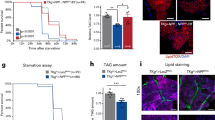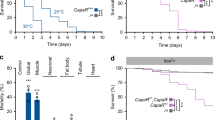Abstract
THE molecular structure of locust adipokinetic hormone (AKH) (ref. 1), closely resembles that of the only other arthropod neurohormone to be fully characterised, prawn red-pigment-concentrating hormone (RPCH) (ref. 2). The first eight residues of the decapeptide, AKH, are homologous with the octapeptide, RPCH, except for threonine instead of serine as residue 5, and asparagine instead of glycine as residue 7, as shown below.  Although both hormones are the products of neuroendocrine organs, such close similarities in structure were somewhat unexpected, as the two hormones have completely different physiological actions. AKH in the locust controls lipid utilisation for energy during prolonged flights, by stimulating the release of diglycerides from the fat body3, and regulating their utilisation by the flight muscle4. RCPH in the prawn stimulates the concentration of pigment within the red chromatophores5. We present here evidence that the two hormones can reproduce each other's effects when cross tested on members of the two arthropod groups.
Although both hormones are the products of neuroendocrine organs, such close similarities in structure were somewhat unexpected, as the two hormones have completely different physiological actions. AKH in the locust controls lipid utilisation for energy during prolonged flights, by stimulating the release of diglycerides from the fat body3, and regulating their utilisation by the flight muscle4. RCPH in the prawn stimulates the concentration of pigment within the red chromatophores5. We present here evidence that the two hormones can reproduce each other's effects when cross tested on members of the two arthropod groups.
This is a preview of subscription content, access via your institution
Access options
Subscribe to this journal
Receive 51 print issues and online access
$199.00 per year
only $3.90 per issue
Buy this article
- Purchase on Springer Link
- Instant access to full article PDF
Prices may be subject to local taxes which are calculated during checkout
Similar content being viewed by others
References
Stone, J. V., Mordue, W., Batley, K. E., and Morris, H. R., Nature, 263, 207–211 (1976).
Fernlund, P., Biochim. biophys. Acta, 371, 304–311 (1974).
Mayer, R. J., and Candy, D. J., J. Insect Physiol., 15, 611–620 (1969).
Robinson, N. L., and Goldsworthy, G. J., J. cell. comp. Physiol., 89, 369–377 (1974).
Fernlund, P., Mar. Biol., 2, 13–18 (1968).
Thomsen, M., Biol. Meddr., 19, 1–38 (1943).
Brown, F. A., and Meglitsch, A., Biol. Bull. mar. biol. Lab., Woods Hole, 79, 409–418 (1940).
Hogben, L., and Slome, D., Proc. R. Soc., B 108, 10–53 (1931).
Josefsson, L., Gen. comp. Endocr., 25, 199–202 (1975).
Brown, F. A., and Wulff, V. J., J. cell. comp. Physiol., 18, 339–353 (1941).
Wallis, M., Biol. Rev., 50, 35–98 (1975).
Author information
Authors and Affiliations
Rights and permissions
About this article
Cite this article
MORDUE, W., STONE, J. Comparison of the biological activities of an insect and a crustacean neurohormone that are structurally similar. Nature 264, 287–289 (1976). https://doi.org/10.1038/264287a0
Received:
Accepted:
Issue Date:
DOI: https://doi.org/10.1038/264287a0
This article is cited by
-
Structure-activity relationships on hyperglycemia by representatives of the adipokinetic/hyperglycemic hormone family in Blaberus discoidalis cockroaches
Journal of Comparative Physiology B (1990)
-
Color change in exercising crabs: evidence for a hormone
Journal of Comparative Physiology B (1984)
-
Peptides in the sinus gland ofCardisoma carnifex: isolation and amino acid analysis
Journal of Comparative Physiology ? B (1983)
Comments
By submitting a comment you agree to abide by our Terms and Community Guidelines. If you find something abusive or that does not comply with our terms or guidelines please flag it as inappropriate.



